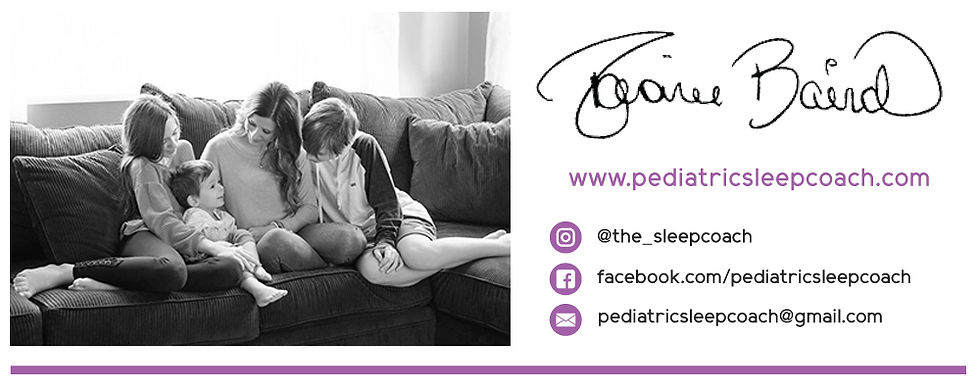How and When to Transition your Little One to a Big Bed
- Desiree Baird
- Sep 27, 2022
- 4 min read
The time has come. Moving your toddler to a “big bed” is an important, yet scary, milestone. Some children transition with no issues, and others reject the idea or constantly come out of their bedroom at night which is disruptive to their sleep and yours.
I’m here to guide you through the transition by explaining:
- How to recognize when to make the move?
- How to prepare for the transition?
- What the most common sleep trouble I see when parents attempt the transition?

When is the ideal time to transition your little one from their crib?
I personally like to keep a child in a crib as long as possible, and at least to age 3 – 3.5, so they can understand to remain in their bed and bedroom. However, it doesn’t always work this way and parents need to transition their child a year or so earlier for reasons such as climbing or personal reasons like maybe your baby was once co-sleeping with you and now you and your partner would like to have your bed back.
It is common for a child to resist the change, even if they have been asking or seem excited about the new bed. Change is hard for some kids, and for even some adults. If your little one doesn’t seem excited once the bed is in place you don’t have to force them in their new bed just yet, you can keep the crib up and just get them used to the idea of the new bed being in their room.
Is there anything we should do to prepare for the transition?
When working with parents, the first thing I make sure is that the room is completely baby proofed. Your child will have free reign of the room so it’s important to make sure everything is safe and secure. Securing furniture to walls, keep small toys (or all toys) out of the room, covering electric outlets, etc. You may even want to put a doorknob safety cover on the inside of the room so your child cannot just leave the room in the middle of the night. Oh, and be sure to check out cords from blinds. I don’t want parents to forget ANYTHING when they are baby proofing the room. Kids seem to find all the small things available to them.
The second thing is to prepare your child mentally for the change. Get them excited and involved. If they are old enough allow them to choose the sheets and comforter. Consider purchasing an OK to Wake Clock if your child is 2.5 or older so they can understand time and when it’s morning. Books on the bed transition are an option too. Here are a few of my favorites:
The last thing you may want to do is role play with your child, especially if you are using the OK to Wake Clock. Show them how to lay in their bed, and what the new arrangements look like. Show them how the OK to Wake Clock works and be sure to communicate with them that it’s important for them to remain in their room during sleeping hours. The goal is that your child sleeps in their room, sometimes children begin to sleep on the floor during the transition and that’s ok. Look at this as a success still and know that this is a phase, and this too shall pass.

Most common issues I see when going through the crib to bed transition, and how to help your little one through the change.
The most common sleep trouble I see with children when transitioning to a big bed is that the child’s door was not closed, or baby proofed so the child decides to leave the room when he or she wants to.
That's right, parents tend to come to me because their child is leaving the room in the middle of the night, or at bedtime, several times and sleep becomes completely disrupted for the whole family. Therefore, a baby proof doorknob cover or a baby gate at the door (if your child doesn’t climb) is non-negotiable so that the child does not exit the room.
I’ve worked with children that escaped at night only to find them at the refrigerator helping themselves to food, or worse yet – outside because they opened the sliding door in the kitchen and luckily a family member woke up to find them leaving the house. SCARY!!!! Keeping your child in their room is not cruel, it’s a safety issue and it’s important for parents to understand this.

Additional tips!
Sometimes a child is still resisting their new bed or are upset about the transition. In this situation, it’s important to really PRAISE your child.
Create a rewards / sticker chart
Be consistent and be confident so that your child feels confident as well
Tell your little one how proud you are that they are now sleeping in a big bed (even if behind the scenes it makes you teary eyed because they are growing up)
Spend some extra 1:1 time with your child in the evening so they can feel safe, secure, and connected. Be fully present with your little one.
Reiterate your boundaries and be sure to follow through and be consistent, but in a loving and caring manner.
And if you have tried everything I mention in this post, and still need help, please reach out so I can help you make a gentle plan to get your kids sleeping well, independently, and peacefully in their new bed. Feel free to reach out to schedule a FREE discovery call at pediatricsleepcoach@gmail.com.






Comments